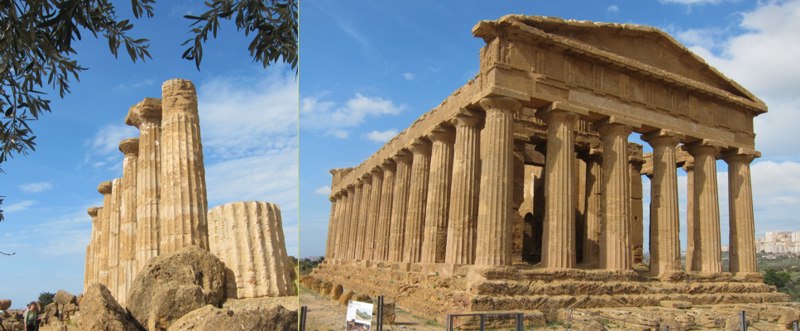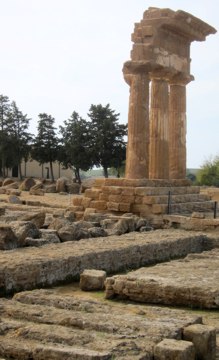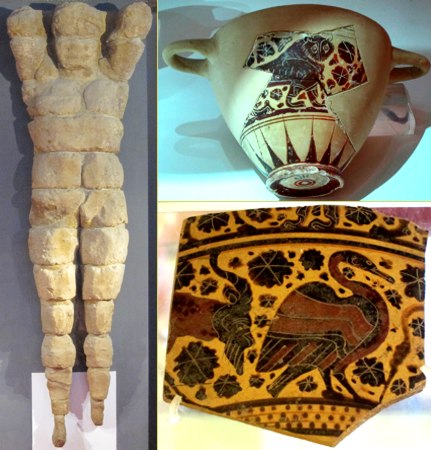| itinerary < 30 October Siracusa, Sicilia 3 November Marsala, Sicilia > | Agrigento, Sicilia 1 November 2011 |
Valle dei Templi: Doing Right by TreasuresAt last, wonders well presented! We knew it could be done, and from our first view, we knew we were in for something special. Among the primary wonders: a magnificent site can be presented magnificently well! No half-kilometers of tacky gift shops between ticket sales and the treasures. Plenty of informative signage in Italian and English. Enough space so that tour groups just blend (mostly). And, as far as I can tell, better preserved Greek temples than anything I saw in Greece. The temple of Concordia, now brightly lighted for night viewing outside my bedroom, is, except for its roof, intact (and what do you want? they used timbers to hold up the roofs of stone more than two millennia ago!) |
 Templo di Concordia from the highway below |
 left: columns from Templo d′ Ercole -- right: Templo di Concordia |
 |
Along a ridge above a valley leading to the nearby sea, four spectacular temples in various states of decay are laid out along a kilometer and a half of sloping path, with broad stairways leading to special views. This is the eastern side of the Temple of Giunone (Juno) -- all the attributions are, we are solemnly informed, imaginative, as only one of the temples can be clearly identified as to who the honored god or goddess was. Naturally, these beauties have a troubled past. In about 400 CE a local prelate, Gregorius, "cast out" the evil spirits of the temple of Concordia (above) and turned it into a basilica. The arches barely visible in the first view are what remains of his work, and remain because it is their presence that has kept that structure so intact. Confronted by such magnificence, I struggle (as do the conservators) with the problem: do we try to recreate (as did Colonel Hardcastle, the wealthy Brit largely responsible for saving this site) or do we try to delay the inevitable decay. The EU and the Italians have decided on the latter course, and so today the principle conservation effort is to keep what's here in place while it gracefully erodes. |
|
As an extra added distraction, along with these gorgeous IVth Century BCE temples and associated niches, walls, fallen columns, and the like, the site is currently decorated with 17 magnificent statues by Igor Mitoraj, a Polish sculptor now working in Italy, most in bronze, with a distinctly Greek flavor completely in keeping with the spirit of the place. The counterpoint of modern, playful, sculptures with the ancient golden tones of the columns and capitals adds weight and interest, I thought, to both.
|
 |
 Templo di Dioscuri: Castor and Pollux |
Across the road, another group of temples, including one attributed to Ercole, Hercules, because his fallen statues held up the lintel over the door (see below). This was the precinct of the earth gods, called chthonic gods after the Greek word for earth. These were the special subject of women's worship ...and, again, much more of this will be found below.
|
|
Below the chthonic temples, there is a "secret garden," the Kolymbetra, now in the hands of an Italian organization modelled after the British National Trust and beautifully and lovingly maintained as a teaching garden as well as a place of rest. The citrus orcards are varied and profoundly productive; we enjoyed windfalls, a sour orange and a sweet, and a shady sit-down. The orchard employs an ancient Arab technique for watering citrus, based around a gebbia, the reservoir at the right of the picture, from which trickles a constant stream of water, distributed through the saja (canal, in the center of the frame) to small vattali reaching to each tree. I can imagine the maintenance of this efficient, delicate, and ancient system comes close to being a meditation for the orchard keeper. |
 |
|
We pretty much wore ourselves out wandering and looking, and while the weather was great for looking, it was getting hot. But we had an ace up our sleeve: before coming to the site, we treated ourselves to a night at the nearby 5-star Villa Athena, visible from the site and an easy walk away. We came back for a shower before lunch, and as Rochelle was finishing her shower, she called out, "Michael, you've got to look at this!" Out the little oval porthole window in our bathroom, there is the Tempio della Concordia, Gregorius's arches and all. As I write, from out balcony the horizon is lit up with the whole row of temples. |
 |
 |
|
After by far the best breakfast of the trip so far -- a delicious omelette, fresh squeezed juices, high quality tea made with really hot water, this morning's pastry; these five star guests really know how to live! -- we walked up the hill to the museum, every bit as well presented as the temples, and almost too rich. Much of what is displayed, in orderly, well organized and documented case after case, are pieces and shards. Ercole (at right) fell from erosion of his soft sandstone parts, but many of the shards, some lovingly restored into their presumed original shapes, suggest that breaking the pottery may have been part of the offering procedure. These (at right) are all IVth Century BCE, although the museum contains findings -- a spectacular bronze age axe, for example -- going back to the third millenium BCE, when this site was apparently first inhabited.  |
 Ercole stands 5 meters tall; the shards, mere inches |
 |
 |
On and on and on the museum went; cases full of treasures. At one point Rochelle said, "My mind is going numb, I have seen so much." Only now, in retrospect and looking over the images I chose, I see some of the wonderful resonances that can be found here. This place could occupy you for days or weeks; lucky the staff who gets to wander here, and ponder what these things were meant for. One point I want to call careful and laudatory attention to: I, and others, were free to take as many photographs as we wanted ... and many other visitors were doing that. It's fun to think of how these images have been multiplying themselves all over the planet. Their makers could never have imagined such reach! Thank you, staff of this site, for your careful preparation and superb display, and also for the sensitivity and good sense to realize that we can't take the time we need to digest these offerings, but need to capture them, take them home, share them with friends, and puzzle over them as you do.

And so, onward around the lower left corner of Sicily to the fine old port town of Marsala, now a bit rumpled and frayed around the edges, and not at all a tourist destination, and therefore happy for those who show up. |
 |
updated 18 November 2024 Caspar Time site software and photographs by the Caspar Institute except as noted this site generated with 100% recycled electrons! send website feedback to the CI webster © copyright 2002-2024 Caspar Institute |